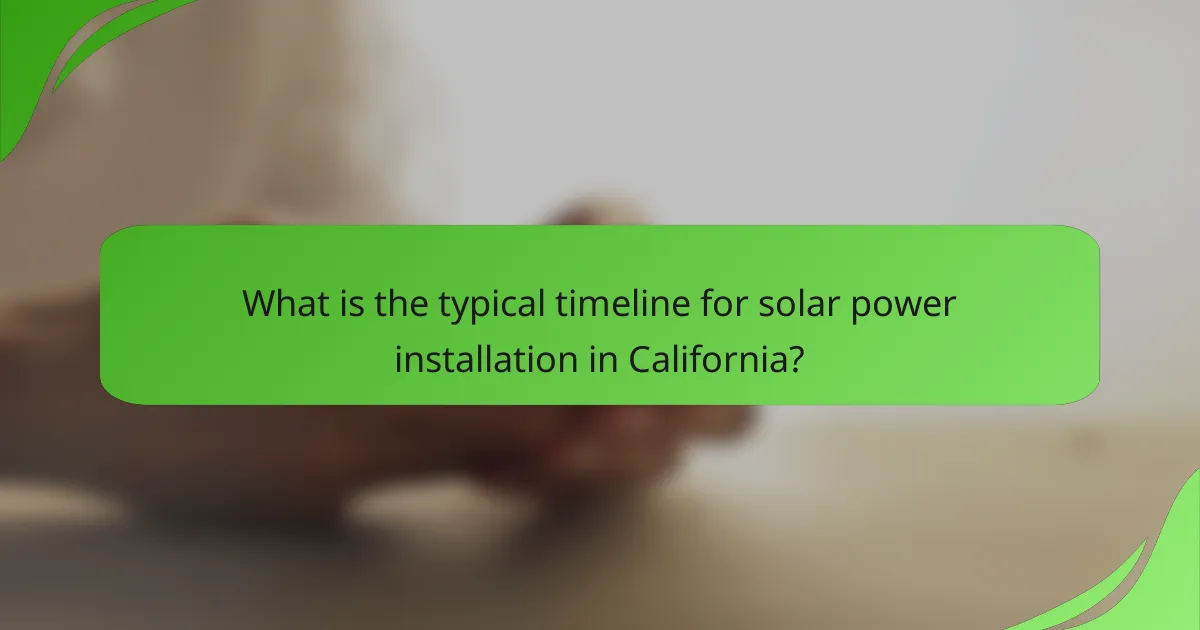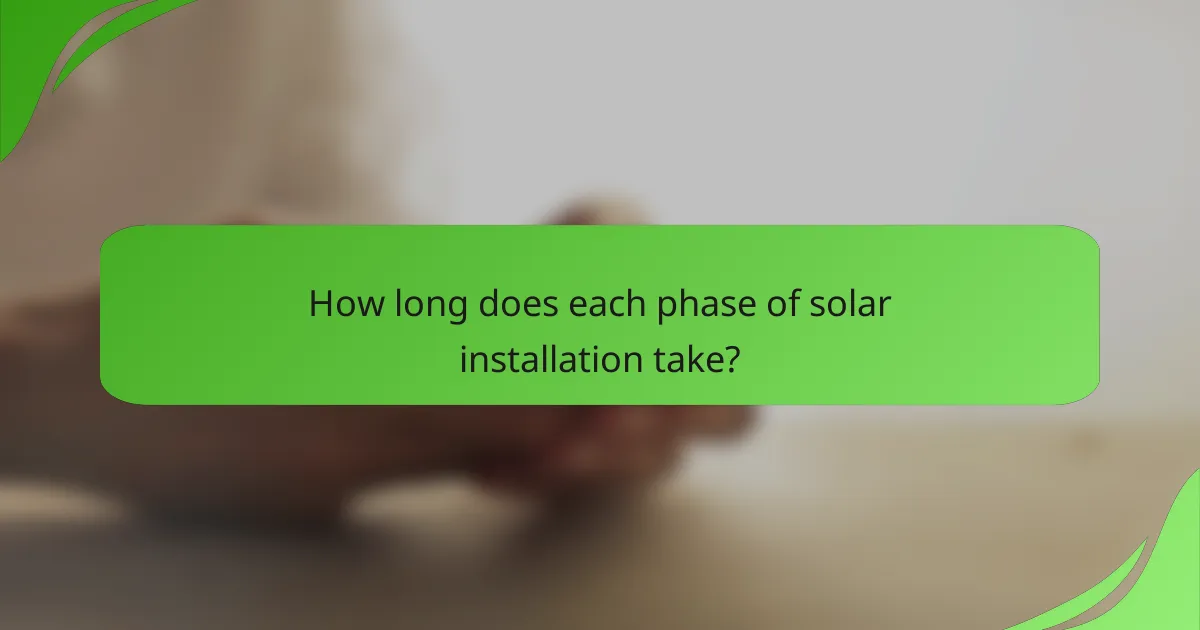Understanding the timeline for solar power installation is essential for homeowners looking to transition to renewable energy. Typically, the process can take anywhere from a few weeks to several months, influenced by factors such as system size, permitting requirements, and installation complexity. Each phase, from initial consultation to final inspection, plays a crucial role in ensuring a successful solar energy implementation.

What is the typical timeline for solar power installation in California?
The typical timeline for solar power installation in California ranges from a few weeks to several months, depending on various factors such as system size, permitting, and installation complexity. Homeowners should prepare for a process that includes planning, permitting, and actual installation phases.
Average project duration
On average, the entire solar power installation process in California can take anywhere from 1 to 3 months. This duration includes time for obtaining necessary permits, scheduling inspections, and completing the installation itself. Larger systems or those requiring extensive permitting may extend this timeline.
It’s crucial to factor in potential delays due to weather, supply chain issues, or local regulations, which can affect the overall timeline. Homeowners should maintain open communication with their installation company to stay informed about progress and any changes.
Key phases of installation
The solar installation process typically involves several key phases: consultation, design, permitting, installation, and inspection. During the consultation phase, homeowners discuss their energy needs and receive a preliminary quote. The design phase involves creating a customized plan that meets those needs while adhering to local regulations.
Once the design is finalized, the permitting phase begins, where necessary approvals are obtained from local authorities. After permits are secured, the installation phase takes place, which usually lasts a few days. Finally, an inspection is conducted to ensure the system meets safety and performance standards before it is officially activated.

What steps are involved in the solar installation process?
The solar installation process consists of several key steps that ensure a smooth transition to solar energy. From the initial consultation to final inspection, each phase is crucial for the successful implementation of your solar power system.
Initial consultation
The initial consultation is the first step where you discuss your energy needs and goals with a solar provider. This meeting typically includes an overview of available solar technologies, financing options, and potential savings on your energy bills.
During this phase, it’s essential to ask questions about the installation process, warranties, and maintenance to ensure you have a clear understanding of what to expect.
Site assessment
A site assessment involves a thorough evaluation of your property to determine its suitability for solar installation. This includes analyzing roof orientation, shading from trees or buildings, and structural integrity.
The solar provider may use tools like shading analysis software and may take measurements to design an optimal solar system tailored to your property.
Permitting and approvals
Before installation can begin, your solar provider will handle the necessary permitting and approvals required by local authorities. This step ensures that your installation complies with building codes and zoning regulations.
Depending on your location, this process can take anywhere from a few days to several weeks, so it’s important to factor this time into your overall project timeline.
Installation
The installation phase typically takes one to three days, depending on the size of your solar system. During this time, solar panels, inverters, and other components are installed on your property.
It’s crucial to ensure that the installation team follows best practices and safety standards to avoid any future issues with your solar system.
Inspection and interconnection
After installation, an inspection is conducted to verify that the system meets local codes and regulations. This step is essential for ensuring the safety and efficiency of your solar power system.
Once the inspection is passed, your system will be interconnected to the grid, allowing you to start generating solar energy and potentially receiving credits for excess energy produced.

How long does each phase of solar installation take?
The timeline for solar installation varies by project but typically spans several weeks to a few months. Each phase, from consultation to installation, has its own duration influenced by factors like local regulations and the complexity of the system.
Consultation duration
The consultation phase usually takes about one to two weeks. During this time, solar providers assess your energy needs, evaluate your property, and discuss system options. It’s essential to gather all necessary information, such as your energy bills and roof specifications, to expedite this process.
Scheduling a consultation promptly can help ensure a smoother transition into the next phases. Be prepared with questions about financing, equipment, and warranties to make the most of your meeting.
Permitting timeline
The permitting timeline can range from a few weeks to several months, depending on local regulations. Most municipalities require permits to ensure compliance with building codes and safety standards. This phase is crucial as it can significantly delay the overall project if not managed efficiently.
To minimize delays, check with your local government about specific requirements and gather all necessary documents beforehand. Engaging a solar installer familiar with local regulations can also help streamline this process.
Installation duration
The actual installation of solar panels typically takes one to three days, depending on the system size and complexity. Smaller residential systems may be completed in a day, while larger installations could require additional time for setup and inspections.
After installation, an inspection is often necessary to ensure everything meets local codes. This can add another week or so to the timeline. Planning for this inspection in advance can help avoid unexpected delays in getting your system operational.

What factors can affect the installation timeline?
The installation timeline for solar power systems can vary significantly based on several key factors. Understanding these factors can help you better anticipate potential delays and streamline your project.
Weather conditions
Weather conditions play a crucial role in the solar installation timeline. Adverse weather, such as heavy rain, snow, or extreme temperatures, can halt work and delay progress. Ideally, installations are best conducted during mild, dry seasons to ensure safety and efficiency.
For instance, in regions with harsh winters, planning your installation for late spring or early fall can minimize weather-related delays. Always check local forecasts and seasonal patterns to choose the optimal time for your project.
Permitting delays
Permitting delays can significantly impact the timeline of your solar installation. Local regulations often require permits before installation can begin, and the approval process can vary widely by location. In some areas, it may take a few weeks to several months to secure the necessary permits.
To mitigate these delays, research local permitting requirements early in your planning process. Engaging with your installer, who is familiar with local regulations, can help expedite this stage and ensure all documentation is in order.
Equipment availability
Equipment availability is another factor that can influence your solar installation timeline. Supply chain issues or high demand can lead to delays in obtaining solar panels, inverters, and other necessary components. It’s not uncommon for certain brands or models to have longer lead times.
To avoid potential setbacks, discuss equipment options with your installer early on. Consider choosing readily available products or brands with a reliable supply chain to help ensure your project stays on schedule.

What are the prerequisites for solar power installation?
Before installing solar power systems, several prerequisites must be met, including site suitability and financial considerations. Understanding these factors will help ensure a smooth installation process and optimal system performance.
Site suitability
Site suitability is crucial for effective solar power installation. Factors such as roof orientation, shading from trees or buildings, and structural integrity must be assessed. Ideally, a south-facing roof with minimal obstructions will yield the best energy production.
Additionally, local regulations may dictate specific requirements for installations, including setbacks and height restrictions. It’s advisable to consult with a professional installer who can evaluate your site and provide tailored recommendations.
Financial considerations
Financial considerations play a significant role in the decision to install solar power. Homeowners should evaluate the total costs, including equipment, installation, and potential maintenance. In the U.S., the average residential solar system can range from $15,000 to $30,000 before incentives.
Incentives such as federal tax credits or state rebates can significantly reduce upfront costs. It’s essential to research available financial options and calculate the return on investment, factoring in energy savings and potential increases in property value.

How can you choose the right solar installer in California?
Choosing the right solar installer in California involves assessing their experience, certifications, and customer feedback. Look for installers who are licensed, insured, and have a solid track record in your area to ensure a successful installation.
Researching local installers
Start by searching for solar installers in your local area. Utilize online directories, local business listings, and solar energy associations to compile a list of potential candidates. Focus on companies that have experience working in California, as they will be familiar with state regulations and incentives.
Consider reaching out to local community groups or forums where residents discuss their solar experiences. This can provide insights into which installers have a good reputation and which ones to avoid.
Evaluating customer reviews
Customer reviews are a vital resource when evaluating solar installers. Look for feedback on platforms like Google, Yelp, and the Better Business Bureau. Pay attention to both positive and negative reviews to gauge overall customer satisfaction and the quality of service provided.
When reading reviews, focus on comments about the installation process, customer service, and post-installation support. A company with consistently high ratings and positive feedback is more likely to provide a satisfactory experience.
